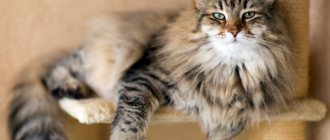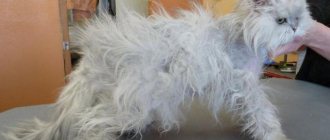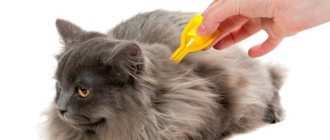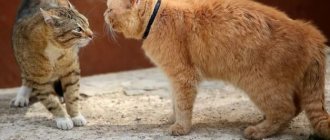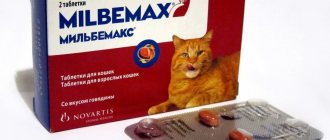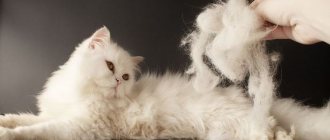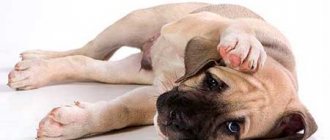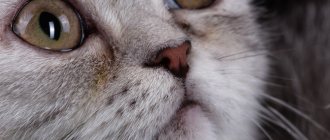When someone adopts a kitten, they expect that the little cat will grow into a large and beautiful four-legged friend with silky hair. But in order for an animal to grow and develop properly, it needs to be properly cared for. Sometimes cats and kittens develop mats on their fur. It is impossible to ignore this, and sometimes it is even dangerous.
- 2 Why mats are dangerous
- 3 How to comb a cat's mats
3.1 Classic combing and cutting
3.1.1 Video: how Persian cats are cut in salons
- 4.1 Photo gallery: types of combs for grooming cats
What are mats?
The fur of cats, especially long-haired breeds, requires careful care. With a lack of hygiene, poor nutrition and other mistakes when keeping pets, their fur begins to deteriorate. This affects not only appearance, but also health.
Older pets cannot provide themselves with the same careful care as younger pets. The wool begins to get tangled, matted, and tangles form. However, young age is not a guarantee that lumps will not appear.
Preventing problems with your cat's coat
Preventive measures for any fluffy long-haired cats, in particular Maine Coons, Siberians, Angoras and Persians, include the following simple rules:
- Brush the animal at least once a week (Persians are scratched more often, sometimes every day).
- To untangle the hair knot, use a special spray.
- When combing your cat's coat, use a comb with round toothed ends so as not to injure the cat.
- When shedding, be sure to remove loose hair using a slicker. At other times, this tool should not be used.
- In extreme heat at the dacha or at home, a very “shaggy” cat should be trimmed. This will not only prevent tangles, but also protect it from overheating and heat stroke.
- Sometimes, to stop the formation of mats, you need to change the cat's food or add a little more fats and vitamins.
A good owner monitors the health of his pet and its appearance. Small fur seals need to be eliminated immediately, then there will be no need for labor-intensive removal of tangles. Simple brushing takes no more than five minutes a day, brings a lot of pleasure to the animal when done correctly and protects it from painful formations in its luxurious fluffy fur.
Causes
If pets are healthy and can take care of their hygiene, they usually do not develop tangles. However, there are cat breeds with fluffy fur and thick undercoat that are prone to ball formation. These include Persians, British, Turkish Angora and others.
Not all long-haired breeds suffer from mats. For example, Siberian cats and Maine Coons rarely develop lumps. Mainly in places of thick and wavy undercoat (on the “collar”, “pants”).
Mats on wool appear for the following reasons:
- the pet is rarely or not brushed at all;
- during the molting period, the animal’s old fur is not combed out;
- the pet is sick;
- the cat is washed with an incorrectly selected shampoo; when soaping, the fur becomes very crumpled, which is why dense clumps are formed;
- the cat is lazy and fat, obese;
- the pet does not eat rationally, which is why it may develop vitamin deficiency (the fur becomes very loose and the risk of lumps forming increases);
- sticky substances (for example, jam, honey, paint, etc.) have come into contact with the fur;
- pathological conditions develop: oncology, parasites, dermatitis, endocrine disorders.
If a pet develops tangles, the owner is to blame. This means he did not take good care of the animal.
Why is a haircut completely or partially undesirable?
Nowadays cat haircuts are gaining popularity. Paying tribute to fashion, owners forget that this is not at all useful for their pet, and sometimes even dangerous. Veterinarians unanimously say that cats can be cut only in case of urgent need: for various skin diseases, in the presence of serious mats in cats, and also in preparation for surgery.
The structure of the coat changes after grooming: the newly grown one becomes thinner, matted areas quickly form ꟷ in this case, the solution again will be to trim the cats’ mats. In some areas the fur does not grow back or takes too long to grow. As a result, the animal’s skin also suffers - it becomes less elastic and elastic, and body temperature decreases. All this can lead to serious illnesses.
Animals have an extremely negative attitude towards the grooming process itself and its result. There are cases of cats trying to injure themselves after being groomed.
Grooming also disrupts thermoregulation - some cats even in the hot summer begin to freeze after a grooming. What can we say about the cold winter? A short-haired cat simply will not move away from the battery.
There is a less serious, but quite important reason for owners of purebred cats, why they should refuse haircuts. The fact is that the appearance of the animal undergoes changes, the fur changes and may begin to curl. Such a cat will no longer be appreciated at an exhibition. Before you cut your pet's hair completely or partially, think about whether your pet needs a change of appearance - or if it's just your whim.
Why are they dangerous?
The appearance of matted fur spoils the appearance of the animal. This is a huge disadvantage for a breeder of purebred cats. In addition, petting a pet with mats is unpleasant.
However, these are not the worst consequences. Mats can provoke the development of various diseases. Pathogenic microorganisms begin to multiply in matted wool. When a pet licks itself, they enter the body and continue their synthesis there.
Fleas, lice, ticks and other parasites take root well in tangles. The skin under the lumps becomes rotten, dermatological problems arise that are difficult to treat. In addition, the cat will try to independently remove matted fur with its claws, and in the process may cause wounds to itself. Such damage will take a long time to heal.
The harm of downed wool to animal health
When mats occur in cats, its natural ability to lick itself is disrupted, the coat becomes dirty and greasy, and this is an excellent breeding ground for microorganisms. Such an animal is at greater risk than others of contracting fungus, lichen, as well as fleas and lice.
Under the rough clumps that matted and compacted fur forms, diaper rash and irritation of the skin appear, and it can become inflamed. In addition, the animal experiences discomfort and pain, as the lumps pull on the skin. If there are a lot of them, the animal suffers greatly and can get sick, and its character even deteriorates.
Removal methods
Tangles are removed from wool in the following ways:
- If the lumps are small, you can comb them out. The pet should be placed on its side and stroked. This is necessary so that he calms down and does not break out. First, comb the sides and back, neck and chest, forelimbs, tail. It is more difficult to get rid of tangles on the stomach and hind legs. Most likely the animal will bite.
- Large clumps are recommended to be cut lengthwise and then combed.
- If there are a lot of tangles, it is completely impossible to comb them out, then the tangled hair will have to be cut to the ground. You need to be very careful: a cat’s skin is thin and can be easily damaged. Clumps can be removed with scissors, people clippers or hair clippers. The receding hairline will heal after a few months.
- At the pet store you can purchase a special device called a tangle cutter. This is a comb with blunt ends, blades between the teeth.
- You can take your cat to a veterinarian or pet groomer. There your pet will be trimmed at an affordable cost.
- To deal with long unnecessary hair, there is a special comb - a furminator. Not only will it help get rid of clumps, but it will also be an indispensable tool for daily combing.
Prevention of tangles
The appearance of tangles can be prevented. To do this you need:
- comb the cat once a day or at least once every 2 days for 10 minutes, and this should be done with different types of combs: for the undercoat;
- for fluff;
- for guard hairs;
- Additionally, stock up on massage combs that stimulate blood microcirculation in the skin capillaries, which provides nutrition to the hair roots;
- the furminator is another good combing device that allows you to easily remove dead hair and fluff;
Using a furminator, you can quickly remove dead hair and fluff from a cat's coat.
Pets can be cut for the summer
You need to care for your cat's long hair like this:
- When bathing, it is better to use special cat shampoos that make the animal’s fur silky and not prone to tangles, for example, the following: Perfect Coat 8 in 1;
- shampoo-conditioner for long-haired cats “Luxury Lioness”;
- Herba Vitae for long-haired cats;
- Biovax shampoo for long-haired cats;
After washing the cat, you need to dry and comb it
Photo gallery: shampoos for long-haired cats
Perfect Coat reduces hair loss Shampoo-conditioner “Luxurious Lioness” restores hair structure and strengthens its roots Natural extracts of heather and hawthorn in Biovax shampoo have wound-healing and tonic effects Herba Vitae contains extracts of knotweed and horsetail and has a beneficial effect on the skin and coat
Video: how to properly comb a cat
Rules for removing mats in cats
Recommendations for removing mats:
- The process of eliminating lumps is long. Most likely, your pet will not like it. The pet will not give in and will start fighting. Therefore, it is better to comb out tangles together: one person holds the cat, the other combs it. If the animal is very nervous, then it is better not to traumatize its psyche and get rid of the matted fur not at once, but several times.
- Only areas with long hair are clipped. It is better not to touch the paws and head. It's okay if your pet looks like a lion. The fur will grow back in a couple of months.
- Until the mats are removed, washing the animal is prohibited. After water, lumps are more difficult to comb out.
- After combing, treat the pet's fur with an antistatic spray. The product will detangle your hair and prevent further formation of tangles.
What danger lies in matted fur?
Of course, tangles do not pose a danger to the life of the animal. Nevertheless, their appearance cannot be ignored for many reasons:
- because of the unaesthetic appearance - no one will like walking around with matted hair;
- due to discomfort - the cat experiences anxiety, because its skin under the tangles is tightened, which does not allow full movement, causing pain;
- due to damage to the skin at the site of the appearance of uncomfortable hairballs, for example, due to them, the skin can become too dry, which provokes dandruff, or too wet, which causes ulcerations and inflammation;
- due to the proliferation of bacteria and fungi on the affected areas of the skin.
Types of tools
If lumps have already formed on your beloved cat’s fur, and a comb and hands do not help, it’s time to buy a mat cutter. When you go to pet stores, you can find on the shelves four dissimilar and completely different in shape tools. At the same time, they perform different functions, so for high-quality care for your pet you will have to purchase several types.
Horizontal
Externally, this tool looks like a vegetable peeler or a knife for cutting vegetables into small noodles. Its blades are sharp on one side and rounded on the other. This ensures safe contact with the cat's skin and does not injure it.
The horizontal model is the most universal: it is suitable for animals of different breeds and sizes. Even a beginner can easily cope with its use.
Vertical (side)
Similar to a classic comb with long straight or curved teeth. Hooks on the blades not only provide safety, but also perfectly pick up tangles from under the bottom, and cut them off much more efficiently.
This model is suitable for hard-to-reach places and for more professional use.
Electric
A specialized tool with one blade and a built-in motor. It is used to remove lumps from hard-to-reach places: ears, groin area, paws. The blade of the tool is protected by a plastic cover on the outside, which makes it safe to use. To use an electric hair cutter, it is advisable to have a certain skill - to at least once watch how a professional groomer handles it.
teardrop-shaped
This mat cutter is used for cats that have mats in hard-to-reach areas: ears, armpits, groin area or paws.
It has only one blade and is suitable for those animals that get stressed by the sight of grooming accessories. This type is convenient to use to remove small tangles without your pet noticing. However, if the owner is going to use it for the first time, he should be very careful - it is better to practice in an easily accessible area.
When and how to use a cat hair cutter
To prevent the fur from rolling into clumps, it is necessary to pay special attention to combing during the molting period - in autumn and spring. At this time, it is worth combing the undercoat more often and not allowing fluff to accumulate and thicken. It is recommended to use a furminator - a device for better removal of fallen hairs.
Procedure for removing tangles
In order for an adult cat to accept any hygiene procedures with pleasure, it must be taught to do so from a very early age. Over time, the pet understands that the procedure is safe for him and is easy to comb.
Basic tips to make it easier for your cat to deal with the removal of mats:
- do not proceed to the procedure immediately after the cat has eaten or actively played;
- do not try to comb an aggressive animal;
- It is desirable that the cat is relaxed, calm or half asleep;
- It will be better if the combing is performed by the family member whom the cat trusts most.
Before removing the tangle, try to untangle it by hand - sometimes this works. This way the wool is least susceptible to damage. If the manual method does not help, you need to take up the tangle cutter:
- Place your cat on a hard, stable surface so she feels safe.
- Work only on dry fur: do not bathe the cat or wet the mats before the procedure;
- It is important that the owner conveys absolute calm to the cat.
- It is useful to treat the fur with a special powder for easy combing - cat cosmetics are sold in pet stores.
- Removal movements should be smooth and soft - do not pull the fur or cause pain to the animal.
- Move from the base to the tip of the hair.
- Do not apply pressure, do not use force.
- If there are too many tangles, divide the procedure into several short sessions.
Manufacturers often include instructions with the tools on how to use the tangle cutter, although this is intuitive. The procedure itself is not much different from regular combing. It is necessary to start moving in the direction of hair growth. Under no circumstances should you use the tool in the opposite or transverse direction. The teeth should go strictly from the roots of the hairs to the tips.
For effective removal, it is worth alternating combing movements over and under the tangle. You need to try to insert the cloves between the lump and the skin and cut through the wool in this place, gradually separating the tangle.
When not to use a webbing cutter
A mat cutter is a tool for removing problematic hairballs, and it should only be used when a comb and other accessories cannot cope with the problem. It is not suitable for normal daily grooming as it can damage its structure with sharp blades.
If the owner has insufficient experience in using this accessory, it can damage the thin and delicate skin of his pet. Therefore, a tangle cutter cannot be used without prior preparation, at least morally.
There are no special contraindications to the use of a tangle cutter, but it is worth considering the general health of the pet. There should be no lesions or other injuries on his skin, as well as visible symptoms of diseases.
How to care for a mat cutter
A cat hair cutter, like any tool, requires special care. Before use, the blades must be disinfected with an alcohol-containing liquid or boiling water. This must be done carefully so as not to have such a harsh impact on the material from which the body is made. This is usually plastic and can be melted by hot water.
After the procedure, the tangle cutter is cleaned of any remaining wool and put into a case, where it is stored until the next use.
